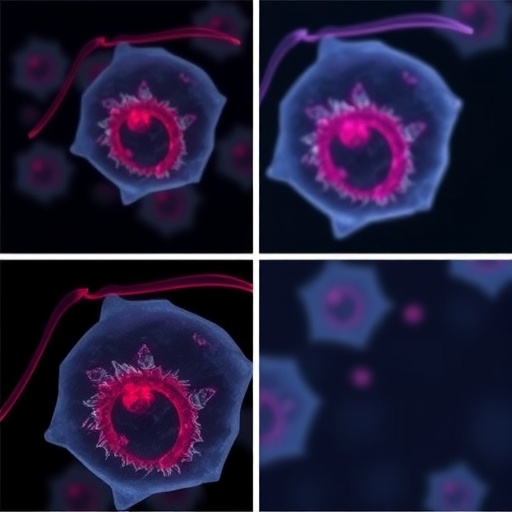Recent research published in the journal Journal of Ovarian Research has unveiled striking findings regarding the mechanisms underlying premature ovarian failure induced by cyclophosphamide in rats. This study led by Wu, Wei, and Peng delves into both cellular senescence and apoptosis—two critical processes that contribute to ovarian deterioration. Understanding these mechanisms is essential for developing therapeutic strategies that could potentially alleviate or prevent chemotherapy-induced ovarian damage, particularly in young female patients undergoing cancer treatment.
Chemotherapy, while effective against malignancies, often precipitates a cascade of side effects that can compromise reproductive health. Cyclophosphamide is one such chemotherapeutic agent known for its efficacy against various cancers, but its gonadotoxicity poses significant risks. The rat model used in this study provides insights that could translate into better treatment outcomes for women who wish to preserve their fertility after chemotherapy. This research emphasizes the importance of studying the cellular and molecular pathways that culminate in ovarian failure.
During the study, researchers established a model of premature ovarian failure by administering cyclophosphamide to female rats. They meticulously monitored the ovarian function over time, noting changes in hormone levels and the ovulatory response. It became evident that implications of cyclophosphamide were far-reaching, affecting not only the ovarian reserve but also the overall reproductive lifespan of the subjects. The results illuminated how this drug could disrupt normal ovarian physiology, leading to premature senescence of ovarian follicles.
Key players in this pharmacological-induced ovarian failure were discovered. The study pointed to increased levels of oxidative stress and inflammation as fundamental contributors to cellular senescence. The researchers elucidated how cyclophosphamide exacerbated oxidative damage, promoting the senescence-associated secretory phenotype (SASP). This phenomenon creates a detrimental microenvironment in the ovaries, where senescent cells release inflammatory cytokines that can further impair ovarian function.
Apoptosis, or programmed cell death, also emerged as a crucial element in the ovarian toxicity of cyclophosphamide. The study detailed how cyclophosphamide activates apoptotic pathways within ovarian follicles, leading to cell death and a reduction in follicular count. By examining the expression levels of key proteins involved in apoptosis, the researchers highlighted the interplay between senescence and death within the ovarian milieu due to cyclophosphamide exposure.
An exciting aspect of this research is its potential clinical applications. Understanding the mechanisms driving ovarian senescence and apoptosis opens avenues for therapeutic interventions. Possible strategies could include using antioxidants to mitigate oxidative stress or employing anti-inflammatory agents to counteract the detrimental effects of SASP. These targeted therapies could aim to preserve ovarian function and fertility among women who face the necessity of chemotherapy.
Furthermore, the study raises awareness about the limited current options available to women suffering from chemotherapy-induced ovarian failure. Although ovarian tissue preservation and hormone replacement therapy exist, they are not widely accessible or applicable to all patients. Insights from this research could lead to more holistic approaches and guidelines for fertility preservation among women before they embark on cancer treatment.
In addition to its immediate clinical implications, this research also adds to the broader understanding of age-related ovarian decline and the factors influencing reproductive aging. Cellular senescence is a natural part of aging, but understanding how exogenous factors like chemotherapeutic agents accelerate this process is crucial. The findings may well extend beyond cyclophosphamide, providing insights into other drugs and their potential effects on reproductive health.
As this field of study progresses, collaboration between oncologists, reproductive endocrinologists, and researchers will be essential. Multi-disciplinary approaches can facilitate the development of comprehensive guidelines for managing fertility during and after cancer treatment. Education and awareness among medical professionals are important to ensure that patients receive accurate information about fertility risks associated with cancer therapies.
Ongoing research in this arena must focus on refining animal models to better mimic human physiology, which will help in translating findings from the lab to the clinical setting. Large-scale clinical trials may be necessary to evaluate the efficacy of potential interventions inspired by the mechanistic insights gathered from studies like this one.
In summary, Wu et al.’s study on the mechanisms of cell senescence and apoptosis in cyclophosphamide-induced ovarian failure provides critical insights into the biochemical and molecular underpinnings of chemotherapy’s side effects on reproduction. The implications of this research are vast, holding promise for improved fertility preservation techniques and better patient care approaches for women facing cancer treatments. As awareness grows surrounding the intersection of oncology and reproductive health, it is hoped that future advancements will lead to less traumatic experiences for women fighting cancer, allowing them the possibility of motherhood after recovery.
In conclusion, the dialogue surrounding the implications of cancer treatments for reproductive health must continue to evolve. With ongoing research into the mechanisms of chemotherapeutic agents and their effects on ovarian function, healthcare providers can better support women navigating these challenges. The ultimate goal remains: to ensure that every woman, regardless of her health circumstances, has the opportunity to fulfill her reproductive aspirations.
Subject of Research: Mechanisms of cell senescence and apoptosis in cyclophosphamide-induced premature ovarian failure
Article Title: Mechanisms of cell senescence and apoptosis in cyclophosphamide-induced premature ovarian failure in rats.
Article References:
Wu, J., Wei, Y., Peng, Q. et al. Mechanisms of cell senescence and apoptosis in cyclophosphamide-induced premature ovarian failure in rats. J Ovarian Res 18, 172 (2025). https://doi.org/10.1186/s13048-025-01759-3
Image Credits: AI Generated
DOI: 10.1186/s13048-025-01759-3
Keywords: cyclophosphamide, ovarian failure, apoptosis, senescence, oxidative stress, fertility preservation




